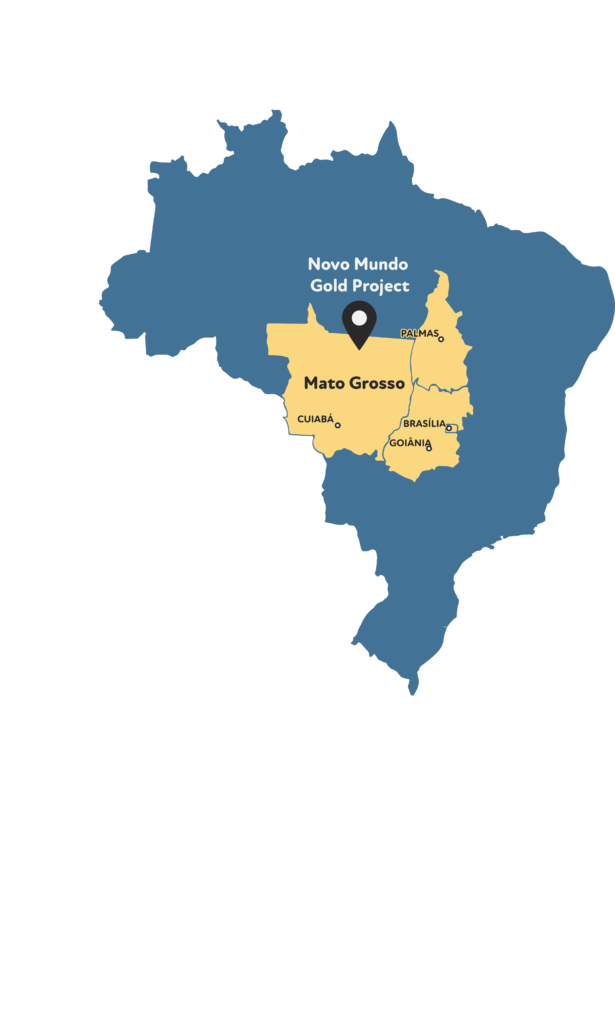740 km from the state capital Cuiabá in in the Alta Floresta Gold Province
3 contiguous Licenses totalling 16,734.94 Ha (167km2 ), 100% owned by the Company

The Novo Mundo gold project is located in the Alta Floresta Gold Province (AFGP) close to the northern border of the state of Mato Grosso, central Brazil. Located within the licence area is the small town of Novo Mundo which developed as a result of historical gold rushes and the growth of the agricultural sector in the region. The town’s coordinates are 9° 58’ 32” South, 55° 10’ 40’’ West and is part of the municipality of the same name. Novo Mundo is 30 km west from the larger town of Guarantã do Norte in the State of Mato Grosso. The Municipality has an estimated population in 2020 of 36,130 inhabitants (IBGE 2020)
The Novo Mundo Gold project involves 3 contiguous ANM mineral processes numbered 866.035/2009, 866.320/2018 and 866.171/2018 with a total area amounting to 16,734.94 Ha. Ison do Brasil Mineração Ltda, Resouro’s wholly owned Brazilian subsidiary owns 100% of the licences.
The climate is seasonal tropical and characterised by high humidity with temperatures ranging from 20°- 36°C. Average annual rainfall is 2,000mm, mostly between November and April. The native vegetation of the region is forest with medium-sized trees corresponding to the Amazon Forest, however, almost all the vegetation present on the surface of the concession package is now cattle pasture. Exploration at Novo Mundo can be completed year-round with some additional challenges during the rainy season.
The area can be accessed from the state capital Cuiabá in approximately 10 hours by car along 740 km of paved highway BR-163. Two regional airports are located within a 4hr drive: Sinop 265 km to the south and Alta Floresta to the west. Regular flights from Brasilia, Cuiabá and Sao Paulo service these airports. The topography is relatively flat with elevation ranging from 248 m to 392 m.
The town of Novo Mundo is the closest population centre and is equipped with all basic local amenities however, Guarantã do Norte, Matupa and Peixoto de Azevedo are larger and better equipped. These three cities make up the regional agricultural hub and as such, there is an abundance of un-skilled and semi-skilled labour, hotels, banks and various small and large equipment suppliers. Within a radius of 40km there are approximately 70,000 people.
Surface water is plentiful in the area with portable pumps capable of providing sufficient water for exploration activities such as drilling. Farm tracks service the majority of property. No power exists on site however two 138 kV power lines pass by the property and the town of Novo Mundo has a residential power supply.
The Novo Mundo project exists within the established gold mining district of the Alta Floresta Gold Belt, Mato Grosso, also referred to as the Juruena Teles-Pires Gold Province (AFGP). This province has a SE-NW elongate extent of over 500 km. It is situated in southernmost portion of the Amazonian Craton at the boundary between the geochronological domains of Rio Negro-Juruena and Tapajos-Parima.
The dominant lithologies in the licence are the granites of the Novo Mundo suite. This suite is compartmentalised into the upper and lower units and represents an intrusive body in rocks of the Xingu Complex with dimensions of approximately 12 km by 5 km, elongated E-W. This orientation coincides with the direction of the main ductile shear zones and regional lineaments that affect the region. The main facies of the Novo Mundo granites consist of an equigranular, leucocratic, non-magnetic syenogranite with an oriented fabric.
A porphyry-epithermal magmatic-hydrothermal system is interpreted to be responsible for the gold deposits of Novo Mundo.
The recent discoveries of disseminated Cu-Au-(Mo) porphyry deposits close to structurally controlled epithermal gold deposits (Jaca, União, & Juruena), reinforce the magmatic-hydrothermal origin and suggest a porphyry-epithermal type association as the main geological-metallogenetic processes in the AFGP.
11 targets have been identified along 3 sub-parallel trends, some of which have been partially tested by previous exploration campaigns. The main trend, ‘Luisão’ has been subject to historic smallscale mining and Resouro has applied for a trial mining licence (“Guia de Utilização”) that gives the company the right to mine and process up to 50,000 tpa.
The historic mining activity was focused only on the top 10m of the mineralised envelopes where oxidation had weathered the veins. Resouro believes considerable high-grade mineralisation continues directly below the artisanal workings and the phase 1 drill program is aiming to confirm this.